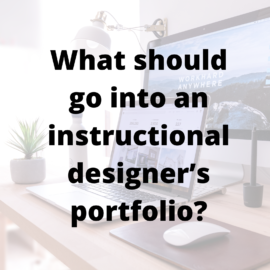I’m teaching a class on “Designing your online professional presence” for instructional designers in the University of Massachusetts-Boston instructional design program. As part of that, I reached out to my various networks and asked those who hire instructional designers to complete a short survey. I had 15 responses from a variety of sectors (9 corporate, 5 freelance, 3 higher ed, 2 government, 2 nonprofit, 1 healthcare). Note that most people had experience in multiple sectors, which is also an interesting thing to know about instructional designers!
I want to thank everyone who completed the survey. This is much more valuable information than anything I might find in a textbook or academic article!
I have to admit that my survey was not particularly well written and had some pretty embarrassing typos! That being said, the information I gleaned from the survey is super valuable. In the following sections, I’ve outlined the key ideas from the survey.
What is the first thing a hiring manager looks for?
The portfolio landing page (which generally is a person’s “about me” page), should have an appealing and modern aesthetic. It should be clean and uncluttered (less is more) and an intuitive interface. The navigation should be simple and well structured.
The landing page should include graphics that support the content of the page, that is, graphics should be meaningful and not simply decorative. In addition, graphics should be included properly – that is, without stretching or warping them.
One person highlighted that there should be 10 seconds of information. More specifically, that what they see in the first 10 seconds should draw them into the site. If it takes longer, they are apt to lose interest.
From a content perspective, there were some different opinions on the level of information. People wanted not only a sense of who you are as an instructional designer, but also who you are as a person.
Specific things that might go on this page include:
- Qualifications including skills and training
- Short fun bio (6-8 sentences) written in first person
- There was disagreement about the need for a photo
- Demonstration of your personal values
- Outline what you hope to achieve (what are you looking for?)
- Explicit accomplishments (data – number of LMSs, number of courses, etc)
- History of your journey into the field
- Link to resume
What types of samples do hiring managers look for?
Hiring managers want to samples that demonstrate the candidates strengths. In addition, for the sample, they would like text that describes the context in which it was created and any key design decisions that you made while creating the sample. They do not want to see examples that look like course assignments (scrub examples you create in courses to remove anything that says it was created for a class).
One manager replies rather succinctly:
I just want to see a 2-3 images and a brief description: 1) Problem you’re trying to solve 2) Learning objectives 3) deliverables 4) Description of your role on your team 5) tools used.
Further to that, managers were more interested in seeing your ability to solve a problem then are to see that you know how to use all the snazzy features of Storyline.
Types of samples include:
- Storyline / Captivate eLearning modules
- Job aids
- Needs assessments
- Course outlines
- Storyboards
- Multimedia scripts
- Program evaluations
Other things to include?
Not all managers are concerned about your technical skills, so much as your interpersonal and social skills. Testimonials are an effective way to demonstrate this.
Does your portfolio need a blog?
I was surprised by the answer to this – only one person thought it was a necessary component of a portfolio, as it helped to see how you think about a problem. One manager highlighted that the blog is useful as for Search Engine Optimization (SEO), but not necessary on a portfolio site.
What not to do?
This is a great checklist of things not to do with your portfolio:
- Don’t include examples that have mistakes.
- Don’t include samples that read like course projects.
- Don’t include examples where someone else did the majority of the work.
- Don’t overdo graphics or transitions – keep things pedagogically sound.
- Don’t use gamification unnecessarily.
- Don’t post documents without context.
- Don’t have broken links on your site.
- Don’t use a crazy layout or cluttered design.
- Don’t include old (outdated) materials.
What do you think should go into an instructional designer’s portfolio? Do you have any suggestions that are missing or any tips to help instructional designers improve their portfolios?


Leave a Reply